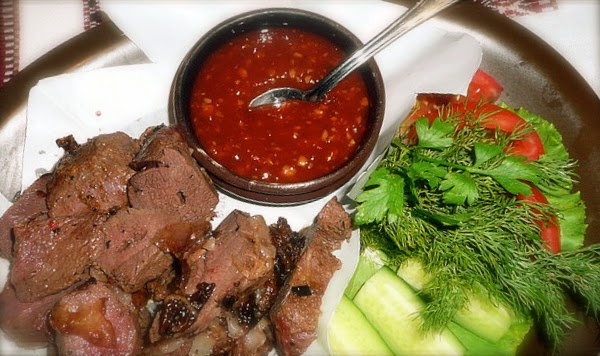Looking Fine, While Fine Dining in Ukraine
Table manners play an important part in making a favorable impression, and are essential to one's personal and professional success. Dining refinements are key because you never get a second chance to make a first impression, like after spilling shashlik sauce on your pants.
Obviously, there is a degree of flexibility involved. It can be hard to project success in certain Kyiv restaurants, where you have to get down on your knees and beg your waitress for a menu, or stand on your chair at the conclusion of your meal and wave your napkin semaphore-style in order to secure the bill. In other words, not every dinner calls for a complete working knowledge of table manners.
 |
| The goal is to behave with graciousness and poise at the table... Slouching is not approved of, regardless of how good you may look. Remember, your posture silently speaks volumes about you. |
“The goal is not, after all, to demonstrate utter mastery of the most arcane details of etiquette,” says an article oncuisinenet.com. “[but] to behave with graciousness and poise at the table.”
Napkin Use
The Table Setting
 |
| Not every dinner calls for a complete working knowledge of table manners, but, again, watch that posture. Good manners means no slouching! And please keep your elbows off of the table too. |
On the far left is typically found the salad fork, followed by the fish fork and meat fork. On the far right you may find a small oyster fork, followed by the soup spoon, fish knife and meat knife. Spoons may also accompany a serving of dessert or coffee and tea. Once used, each should be returned to the saucer (but not bowl) on which it arrived, but never to your dinner plate.
Holding On
 |
| The guides describe the European style as less formal, since you can use your knife both to cut up your food and load up items like peas on your fork. |
Soiled utensils should never touch the table, but remain on the plates for which they were designed (salad fork on salad plate, meat/fish fork and meat/fish knife on dinner plate, etc...). Keep the blade of the knife pointed toward you and the fork tines preferably pointed up or down, but never facing another person. When taking a small break in eating, the fork and the knife should balance on the rim of the plate; when receiving a second helping, they should lie parallel on the right side of the plate; and when you’ve finished your meal, they should lie parallel either across the plate or on a diagonal.
Brushing Up
 |
| Eaten with the fingers ~ Foods which may be eaten with the fingers include artichokes (until you reach the heart), asparagus (when not covered in sauce), crisp bacon... |
Inedible foods should come out of the mouth the way they went in – olive pits in the hand, chicken bones on the fork. But, to repeat, style and flexibility are all-important.
“When a piece of fat is too big to be removed with the fork, use a napkin discretely to discard the meat,” advises the askmen.com Web site, which clearly hasn’t heard of salo, and doesn’t know it should simply be swallowed.
Main article used was originally published in 2003 in the Kyiv Post
🍽Etiquette Enthusiast, Maura J. Graber of The RSVP Institute of Etiquette, is the Site Editor for the Etiquipedia© Etiquette Encyclopedia

No comments:
Post a Comment
Note: Only a member of this blog may post a comment.